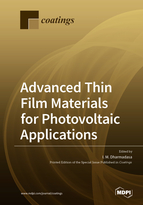Advanced Thin Film Materials for Photovoltaic Applications
A special issue of Coatings (ISSN 2079-6412).
Deadline for manuscript submissions: closed (31 May 2020) | Viewed by 77780
Special Issue Editor
Interests: electrodeposition of electronic materials; semiconductors; solar energy materials; thin film solar cells; photovoltaic solar energy conversion; graded bandgap solar cells; use of clean energy for social development and reduction of poverty; solar villages
Special Issues, Collections and Topics in MDPI journals
Special Issue Information
Dear Colleagues,
This Special Issue is dedicated to critical reviews and original research articles on "Advanced Thin Film Materials for Photovoltaic Applications". The main aim is to share new knowledge on this subject, by publishing the latest developments in materials and thin film photovoltaics.
Thin film photovoltaics have been stagnant for a while, but the progress during the past few years has been very impressive. For example, CdTe, CuInGaSe2, and Perovskite thin film solar cells have all demonstrated ~22% conversion efficiencies. This is mainly due to the progress in understanding and developing new materials and device structures, and improvement in processing steps. It is apparent that many issues relevant to thin film solar cells are common to most of the material systems under investigation at present.
The photovoltaic (PV) community is also focusing their research on next generation solar cells incorporating ideas, such as graded bandgap devices, nano- and micro-rod type materials, grain boundary enhanced current collection, etc., to increase the solar to electric conversion efficiency. This call for papers invites comprehensive reviews from research leaders and relevant original research articles from active researchers from this subject area.
In particular, the topics of interest include, but are not limited to:
- New materials for PV applications
- CdTe and related materials
- CuInGaSe2 and related alloys
- High efficiency Dye sensitized solar cells
- Kesterites
- Perovskites
- Organic PV materials and devices
- Hybrid solar cells
- Graded bandgap multi-layer devices
- New device concepts and architectures for next generation of solar cells
Prof. I. M. Dharmadasa
Guest Editor
Manuscript Submission Information
Manuscripts should be submitted online at www.mdpi.com by registering and logging in to this website. Once you are registered, click here to go to the submission form. Manuscripts can be submitted until the deadline. All submissions that pass pre-check are peer-reviewed. Accepted papers will be published continuously in the journal (as soon as accepted) and will be listed together on the special issue website. Research articles, review articles as well as short communications are invited. For planned papers, a title and short abstract (about 100 words) can be sent to the Editorial Office for announcement on this website.
Submitted manuscripts should not have been published previously, nor be under consideration for publication elsewhere (except conference proceedings papers). All manuscripts are thoroughly refereed through a single-blind peer-review process. A guide for authors and other relevant information for submission of manuscripts is available on the Instructions for Authors page. Coatings is an international peer-reviewed open access monthly journal published by MDPI.
Please visit the Instructions for Authors page before submitting a manuscript. The Article Processing Charge (APC) for publication in this open access journal is 2600 CHF (Swiss Francs). Submitted papers should be well formatted and use good English. Authors may use MDPI's English editing service prior to publication or during author revisions.






